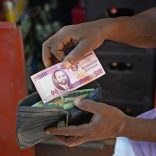Mozambique: Over 204 million dollars channelled to sovereign wealth fund
What happened after the debt was forgiven? Lessons from HIPC/MDRI countries – Analysis

FILE - A view of Maputo. [File photo: Lusa]
There is a broad consensus that a significant share of the resources needed to achieve the Sustainable Development Goals (SDGs) and address the costs of climate change in developing countries by 2030 will need to come from external official development finance—including both concessional and non-concessional bilateral and multilateral sources. While mobilizing such large volumes of development finance will be challenging, we have previously highlighted how absorbing and effectively utilizing these resources would place considerable demands on low- and lower-middle-income countries, many of which lack the necessary institutional and operational capacity. In several cases, the projected inflows of external finance would vastly exceed current levels of revenue, expenditure, and external financing. For instance, if the projected funds were to materialize, annual inflows could exceed 40 percent of GDP in countries such as Burundi, the Central African Republic, the Democratic Republic of the Congo, Madagascar, Malawi, and Mozambique.
As a corollary to that prior work, we now examine the experience of low-income countries that received debt relief under the Highly Indebted Poor Countries (HIPC) Initiative and the Multilateral Debt Relief Initiative (MDRI), launched in 1996 and 2006, respectively. These initiatives, led by the World Bank and the IMF, provided debt relief to eligible countries that met specific criteria related to unsustainable debt levels and the implementation of poverty reduction strategies. By reducing debt burdens, these initiatives aimed to free up resources for health, education, and poverty alleviation.
However, a review of these countries experience from 2000 to 2024 suggests that the anticipated outcomes were not realized. Initially, the share of education spending as a percentage of GDP increased, but the combined budgetary allocation to both education and health did not rise, and health spending as a share of GDP remained flat. Overall public spending continued to increase—driven by both domestic and external borrowing. Growth rates initially increased after debt relief, but started to decline from 2011 onward, despite significant fiscal loosening. Between 2012 and 2025, the average debt-to-GDP ratio doubled, as did the ratio of debt service to revenue. The experience of HIPC/MDRI countries suggest that raising health and education outlays to help low-income developing countries reach the SDGs will require much more than simply increasing the resource envelope.
The HIPC/MDRI experience
Figure 1 shows that the implementation of the HIPC and MDRI initiatives led to a sharp decline in the median debt-to-GDP ratio in HIPC countries—from 86 percent in 2000 to about 30 percent in 2007, a reduction of two-thirds. (“HPIC countries” refers to all countries that received some amount of debt relief under HPIC. MDRI later applied to the same group.) By significantly lowering annual debt service payments, these initiatives created fiscal space in national budgets, potentially enabling increased allocations to education, health, and other poverty-reducing programs. As part of the initiative, HIPC countries were required to prepare a comprehensive Poverty Reduction Strategy Paper (PRSP) every three years, with annual progress reports in the intervening years. This process helped ensure that poverty reduction strategies were regularly updated and aligned with broader development goals.
Figure 1. Gross government debt to GDP, HIPC countries

While budget allocations for education initially rose to 18 percent of total spending, they later stabilized at around 15 percent. However, the same cannot be said for the health sector (Figure 2), where allocations remained largely unchanged from 2000 to 2022—at roughly one-third the level of education spending—except during the COVID-19 pandemic in 2021.
Figure 2. Median health and education spending to total expenditure, HIPC countries

At the same time, the increased fiscal space improved the creditworthiness of these countries in the eyes of foreign lenders. Facing pressures to accelerate development, many also began borrowing from domestic markets. As a result, median public spending increased from 15 percent of GDP in 1996 to over 21 percent in 2025 (Figure 3). While median revenues grew until 2006, they have since stagnated, causing the gap between domestic revenues and spending to widen—from around 2 percent of GDP to 4-5 percent. With increased spending, median growth rates in these countries increased in the aftermath of debt relief, but declined to a lower level from 2011 onwards, reflecting both the poor quality of public expenditures and the weak institutional capacity to manage them effectively—a point we emphasized in our earlier blog.
Figure 3. Median revenue and expenditure to GDP, HIPC countries

This widening fiscal gap led to a steady rise in debt burdens, with the median debt-to-GDP ratio doubling from 27 percent in 2012 to 51 percent in 2025 (Figure 1). Several former HIPC countries are now in or near debt distress, struggling to meet financial obligations and facing the risk of default.
Figure 4. External debt service to revenue, HIPC countries

Importantly, this deteriorating fiscal situation cannot be attributed solely to domestic policy failures. External shocks also played a critical role. A collapse in commodity prices hurt export earnings, followed by the COVID-19 pandemic, which reduced revenues and forced governments to increase spending to protect lives and livelihoods. The subsequent appreciation of the US dollar raised the cost of servicing foreign debt. Russia’s war in Ukraine further drove up import prices.
Collectively, these shocks and domestic policy choices have led to a sharp increase in debt service burdens. Half of all low-income countries are at high risk or already in debt distress, according to the IMF’s Debt Sustainability Framework. This means fewer resources for investments in education, health, infrastructure, and climate action.
There is no doubt that going forward low- and lower-middle income countries will require additional resources to achieve the SDGs and undertake a just climate transition. But the experience of the HIPC/MDRI initiatives demonstrates that increasing spending to finance the SDGs and climate transition is not simply a matter of expanding fiscal space. Even in the years immediately following debt relief granted to HIPC/MDRI countries, the increase in health and education spending was tepid, constrained by significant capacity constraints. And in periods where governments have used up fiscal space by borrowing, the health and education sectors appear to have been shortchanged by the squeeze on the budget imposed by rising debt service payments. It is therefore essential for the development community to complement resource mobilization efforts with an equally stronger focus on addressing the institutional and operational capacity of low- and lower-middle income countries, including through improvements in public financial management. Amid reductions in the provision of bilateral aid, these domestic reforms become doubly important.
By Benedict Clements , Sanjeev Gupta and Charley Ward












Leave a Reply
Be the First to Comment!
You must be logged in to post a comment.
You must be logged in to post a comment.